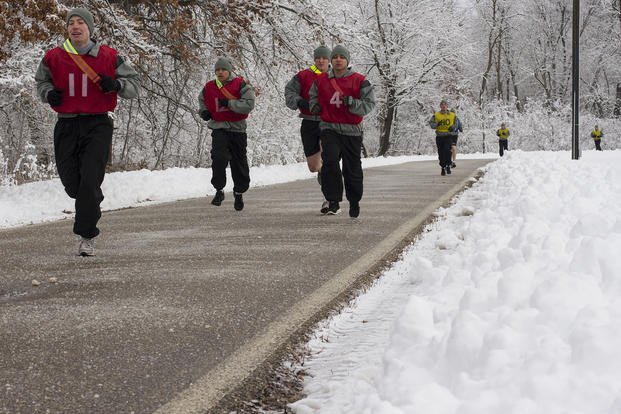Depending upon where you live, training outside can get quite uncomfortable in the winter and, in some places, downright dangerous. Whether you like to maintain your daily walking or running schedule, or you go outside for sports training and calisthenics, winter weather can affect you in several ways.
Depending on what you are training for, you either will want to use gear to be more comfortable or use the cold as a form of gut check to help prepare for cold-weather training, winter racing or sporting events. Do not be stupid and try to challenge yourself by getting wet in below-freezing temperatures, especially if you're wearing shorts and a T-shirt.
Below are some tips, recommend gear and ways to acclimate yourself for lower temperatures, darkness and slippery conditions:
1. Acclimate: If you continue to stay outside throughout the fall and into the beginning of winter, you will find that a steady transition of runs, rucks or outdoor calisthenics workouts is much easier with which to cope. Going from 80-degree days and 30-degree days is not the ideal transition. But if each week, you can be outside when the weather drops into the 60s, 50s and 40s, it makes training when it drops into the 30s much more manageable. In time, though, we can get used to the cold and still maintain high levels of fitness.
2. Extremity protection: A good pair of gloves, shoes or boots, socks and cap will help you with areas that quickly start to go numb or feel the pain of overexposure in the weather. It helps to avoid puddles when running or doing calisthenics on the ground. Having water-resistant clothing can help you when you cannot help yourself. Some of my go-to winter gear includes the following:
- Backpack: I enjoy rucking more than running in the winter, as it just feels safer when in the dark and in sub-freezing temperatures. The pack also keeps the backside warm and your cardio intensity is much less, so pain in the throat and lungs is decreased significantly. Winter is a great time to add in rucking to your training.
- Gloves: Depending on what you need to do with your hands during your outdoor activity, you could go with typical flight gloves, gardening gloves with latex insulation or thicker Thinsulate gloves.
- Socks: I like to wear two pairs of socks. The pair against my skin is a thin polyester/rayon blend, and the outer is a thicker wool/cotton blend such as those made by Drymax.
- Shoes/boots: You need to stay dry when the temperatures are just above freezing and have solid traction when ice is forming at or below freezing temperatures. Products like Yaktrax that slip on over your shoes or actual cleats to run on icy paths can help if you must train in these conditions. I recommend finding a treadmill in these conditions or waiting for the warmest time of the day to run, in case the temperature changes drastically between sunrise and sunset.
- Head and face protection: Don't forget that any exposed skin should have sunscreen or moisturizer applied, as the dry cold can cause pain and irritation. However, you also can protect your head and face using a full face mask (balaclava or ski mask) when it gets really cold and you still prefer to run outside.
3. Stay bright: Run in the winter on bike paths, sidewalks or other places where you will see road traffic; most people will run before or after work or school. It is typically dark at these times. When the days are their shortest, you should have light or very reflective clothing to avoid faster-moving vehicles. A reflective belt or hat, shirt or head lamp are great illuminators for winter runners.
4. Layer: Even your mom knows this one. When you go out in the cold for any activity, make sure you have layers of shirts, underpants and footwear. Compression tights also provide a helpful layer for warmth and support. If you can get some wicking type of clothing against your skin, layer that with thick fleece or wool clothing. The other layer should be more of a thinner windbreaker-type material, depending upon your movement speed and/or the wind speed that day.
The key to training outdoors in the winter is to work smarter, not harder. There is no reason why you can't dress normally with minimal winter clothing for short periods of time, but if you are exposed for greater than 30 minutes in typical winter weather, it is not recommended to pack light.
One of the rules of the outdoors is: Pack light, freeze at night. It applies to running, too.
Stew Smith is a former Navy SEAL and fitness author certified as a Strength and Conditioning Specialist (CSCS) with the National Strength and Conditioning Association. Visit his Fitness eBook store if you're looking to start a workout program to create a healthy lifestyle. Send your fitness questions to stew@stewsmith.com.
Want to Learn More About Military Life?
Whether you're thinking of joining the military, looking for fitness and basic training tips, or keeping up with military life and benefits, Military.com has you covered. Subscribe to Military.com to have military news, updates and resources delivered directly to your inbox.


















